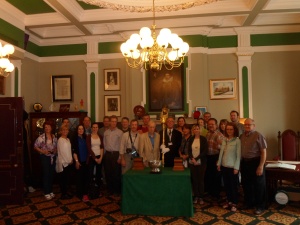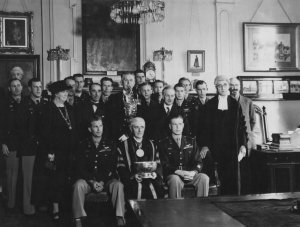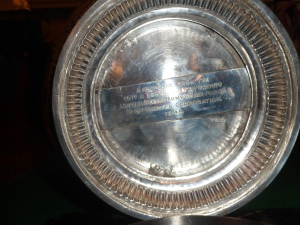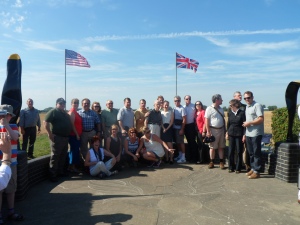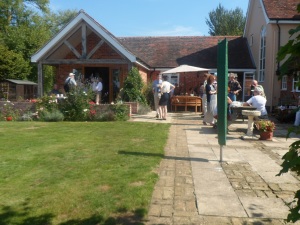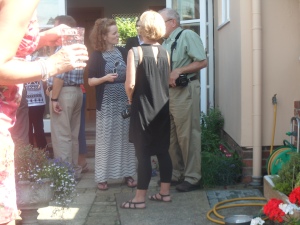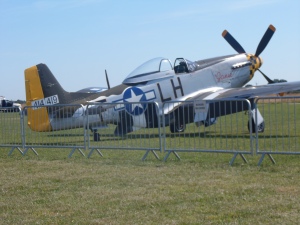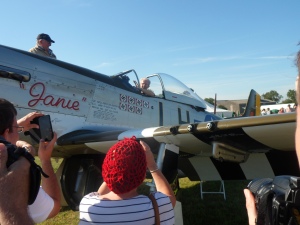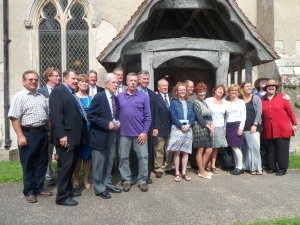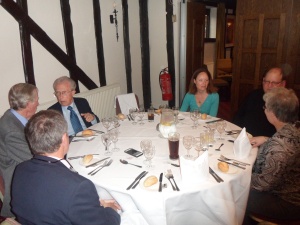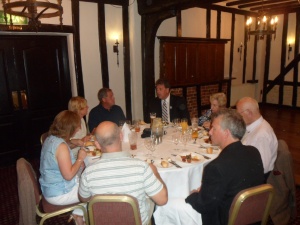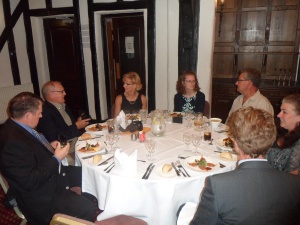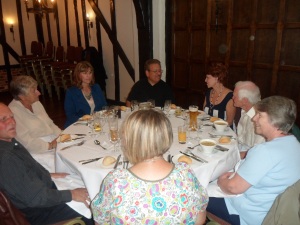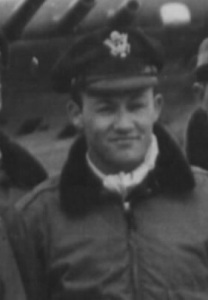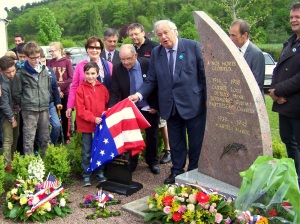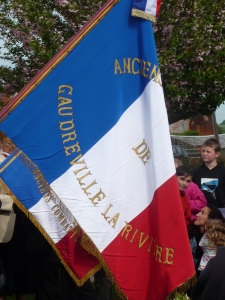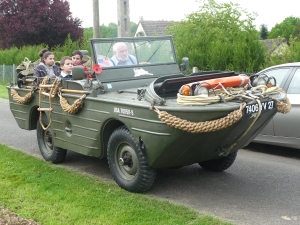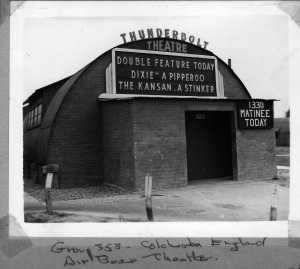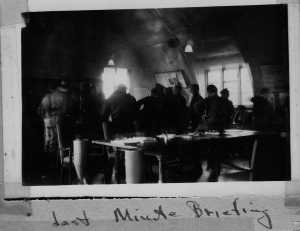The “Last Hurrah” – A Full Report
Time passes quickly when you are having fun and it hardly seems as if the “Last Hurrah” for the 353rd Fighter Group can be over already. The weekend events were a stunning success and here is a full report of all the activities and celebrations.
The events began with a drinks reception and briefing for the twenty-three family members attending at the Rose and Crown Hotel in the town of Colchester on the evening of August 21. We were very lucky to have 350th Fighter Squadron pilot John Madson in attendance with his family and the families of Glenn Duncan, Gordon Compton, Frank King, Tony Rosatone, Galen Bevington, John Davenport and Bayard Auchincloss.
We chose Colchester as the base camp for the weekend as it was a popular destination for group members when they were on leave from their duties. The 353rd made a special friendship with the people of Colchester during World War II so we spent Friday August 22 touring the town. First call was the town hall where we met our guide Mr Ian McMeekin. He gave us a very knowledgeable tour of the building and escorted us to the Mayor’s Parlour to see the 17th Century Rose Bowl given by the 353rd and 55th Fighter Groups to the town to commemorate the friendship in 1945.
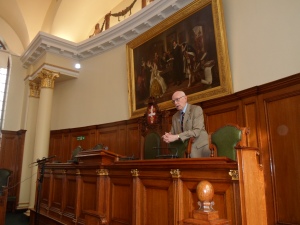
Colchester Town Guide Mr Ian McMeekin describes the Council Chambers to the 353rd Families (353rd FG Archive)

John Madson with Mr Paul Lind, the Town Sergeant, in the Mayor’s Parlour. The Rose Bowl is on the table in front of them (353rd FG Archive)
After our visit to the town hall, Ian McMeekin continued the tour around central Colchester and included a very welcome visit to Timperleys Tea Room. The party then were able to have some free time to explore Colchester’s sights and shops. In the evening Graham Cross, 353rd Fighter Group Historian, gave a presentation to the party on the history of the unit.
Saturday August 23 dawned bright and sunny and the party left the hotel for a 10 am appointment at the Raydon Memorial. Here we were joined by the Peacock family (owners of the former airfield site), an Honour Guard from RAF Mildenhall, the Revd Rosalind Paul, Councillor Jim Lowe and other local representatives for a special service of remembrance. The Raydon Airfield Memorial Group (Mark Manning, Steven Silburn, Mervyn and Maynard Pizzey, Chris Elsey, Janice Rumsey, Bob Gooding and many others) had been working hard to brighten up the memorial and to create a new information board for visitors to the site. The Group installed the board in memory of the late Mr. Jack Peacock who was a good friend of the 353rd Fighter Group and the memorial project.

John Peacock and John Madson unveil the new airfield information board, August 22, 2015 (353rd FG Archive)
The moving ceremony included an Honour Guard of current serving USAF personnel from RAF Mildenhall and words from Glenn Duncan Jr (the son of the 353rd’s Commanding Officer), Revd Paul and Councillor Lowe. The Peacock family, the Raydon Memorial Group and Raydon Parish Council then laid wreaths at the memorial. Members of the 353rd families helped place the wreaths (Glenn Duncan Jr with Mr Tom Peacock, Gary Bargerhuff with Cllr Jim Lowe, and Lou Rosatone with Bob Gooding). A highlight of the ceremony was the joint unveiling of the new information board by John Madson (350th Fighter Squadron) and Mr John Peacock. There was then an opportunity for some photographs before a flypast by Maurice Hammond and Rob Davies in P-51 Mustangs “Janie” and “Marinell.” It really was quite a surprise for the 353rd families as they grouped for a photo around the memorial while the Mustangs approached from behind them coming along the course of the old runway. As an end to the memorial service, 16-year-old Maia Elsey sang ‘We’ll Meet Again’ beautifully to the assembled families with few dry eyes among her audience.

John Madson at the Raydon Memorial with the USAF Honour Guard from RAF Mildenhall (353rd FG Archive)
After the service, the 353rd families headed to Raydon Old Hall for a tea reception as guests of the Peacock family. The Peacocks have welcomed returning veterans, and their families, back to the former airfield many times over the years and it was such a pleasure for the group to reaffirm this friendship. The weather and surroundings were beautiful and the Peacock family had many photos of past reunions to share making the visit especially enjoyable.
Then it was back on the bus to visit the afternoon air show as guests of Mr John Anderson and family. With perfect flying weather, the afternoon promised to be a memorable event. As the 353rd families arrived, John Anderson welcomed them personally and the Wattisham Military Wives Choir treated them to songs. Following a superb lunch, Graham Cross presented the families each with a print of a pencil sketch depicting 352nd Fighter Squadron aircraft gifted by renowned local artist Geoff Pleasance. The families then presented copies of Jonah’s Feet Are Dry‘ that they had all signed to Maurice Hammond, Rob Davies and John Anderson in thanks for the huge contributions they have made to making this event and those in the past possible and so successful.
The group were then able to tour the show site to view a superb historical display put together by members of the memorial group, military vehicles, classic cars and even a steam engine! The highlight of the afternoon was, of course, the static and flying aircraft displays kindly arranged by Maurice Hammond of Hardwick Warbirds. Maurice Hammond and Rob Davies then performed a superb flying display in “Janie” and “Marinell” and it really was a treat to see two Mustangs flown and displayed so skilfully to honour the 353rd Fighter Group. When the Mustangs landed, we were all able to get an even closer look at the aircraft with the opening of the safety fences. As a special treat, John Madson was able to sit in the cockpit of “Janie” and had the biggest grin seen on the airfield that day! Sadly, the day had to end and a tired and contented group headed back to the hotel.
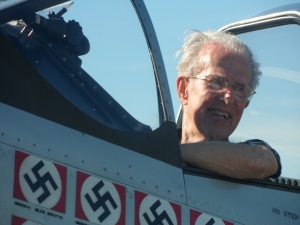
John Madson seated in the cockpit of “Janie” by kind permission of Maurice Hammond. Surely the biggest grin on the field that day! (353rd FG Archive)
Sunday August 23 saw the group join local people at a special service in St Mary’s Church, Raydon. Revd Rosalind Paul led proceedings and we heard from Revd Josefa Mareira (Chaplain at RAF Wattisham). Revd Paul then rededicated the Memorial Vestry Doors donated by the 353rd in 1984. After the service, there was a very enjoyable social occasion where the families could talk to local people. The party then boarded the bus and headed to lunch as guests of the Raydon Airfield Memorial Group at the ‘Case is Altered’ Pub in Bentley. By this stage, the weather had closed in and after a brief stop at the old airfield, the group headed to Dedham to visit craft shops and the very fine church there. Sadly, due to the worsening weather, a trip to Metfield by some of the party had to be cancelled.
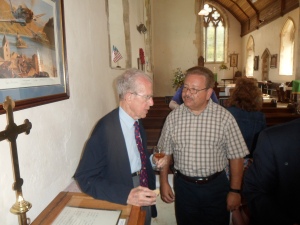
John Madson and Lou Rosatone talk at the book of remembrance at St. Mary’s Church, Raydon (353rd FG Archive)
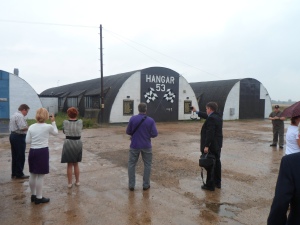
Is this the same country? The heavens open as the 353rd Families explore the old briefing and ready room complex at Raydon (353rd FG Archive)

John Madson back at Raydon after 70 years – after the war he pursued a successful career as an architect (353rd FG Archive)
Monday August 24 saw the heavens truly open and the rain descend in a way it only can in England. Undeterred the party headed to the Cambridge American Military Cemetery for a very moving visit. The group were able to tour the brand new visitors centre at the cemetery and visit some of the graves of 353rd Fighter Group. There are six 353rd men buried at Cambridge and a further ten commemorated on the walls of the missing. The Superintendent had also kindly arranged to have the 353rd graves marked United States and British flags. The party then split with some choosing to visit the Imperial War Museum at Duxford and some heading into Cambridge for lunch at the ‘Eagle’ Pub (famous for the aircrew signatures on its ceiling and walls) followed by a tour of King’s College Chapel and Queens’ College.
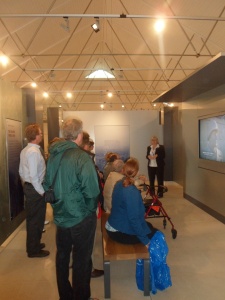
353rd Families watch a presentation at the new visitors centre at the Cambridge American Military Cemetery (353rd FG Archive)

Jane Joseph and Katy Carter, daughters of G B Compton, sought out William Maguire’s grave at Madingley. Maguire and their father were great friends (353rd FG Archive)
In the evening, there was a farewell dinner at the Rose and Crown for the families and local people. We were also lucky to have Jean Freeman (wife of the late Roger Freeman) attend. Gary Bargerhuff read a very moving poem by Galen Bevington entitled ‘The Cause’ and particularly poignant as Galen was killed in action November 25, 1944. Proceedings closed with a toast to the men of the 353rd Fighter Group.
With the events now at an end, we can reflect that it really was a very successful visit. It involved a good deal of hard work by many people, but every bit was worth it. The new experiences and friendships formed in remembering the 353rd together are something to truly treasure. To our new American friends we say safe journey and ‘Haste ye back!’
Filed under 353rd Fighter Group
Francis N. King and Jack R. Walsh, 351st Fighter Squadron
It is with great sadness that I have to report that we have lost two original cadre pilot members of the 351st Fighter Squadron within days of each other. This post is made with condolences to the families of Frank King and Jack Walsh and with thanks to Susan King (daughter of Frank) and Marilynn (daughter of Jack) for passing on the the sad news.
Francis N. King
Francis N. ‘Frank’ King, born March 6, 1920 in McCormick, S.C., died on July 2, 2015 in Fountain Hills, Arizona. He enlisted as Aviation Cadet in January 1942 and completed pilot training 9 October of that year at Moore Field, Mission, TX, Class 42-I. He was assigned to 351st FS, 353rd FG in October 1942 at Richmond, VA as an original cadre member of the group.
Frank arrived in Britain 6 June 1943 and completed theatre training at Goxhill. He flew combat from Metfield and Raydon in his P-47 Thunderbolt he named ‘Gator Bait’. He flew fighter sweeps, bomber escort, dive-bombing, and strafing. He flew the Schweinfurt and first Berlin escort missions. He also flew the 353rd’s first dive-bombing missions in the P-47.
Frank was credited with 105 missions. Awarded the Distinguished Flying Cross with cluster, Air Medal and three clusters. After combat, he transferred to 27th Air Transport Group, Belfast, Ireland. Here he flew new aircraft to combat bases, including P-47, P-51, P-38, B-26, A-26, B-24, B-17, and C-47. He flew troops and cargo around the ETO and on one occasion even flew a Piper Cub to Paris from Scotland and toured Paris prior to troops entering the city.
Frank returned to the U.S. October 1, 1944. He was then assigned as a P-47 combat instructor at Richmond, Va and completed a tour as test pilot. He was released from active duty August 27, 1945 as a Captain.
After the war, Frank was employed in the printing industry and attended Temple University studying Business Administration. He also graduated from the Industrial College of the Armed Forces and Air War College. His civilian occupations included Training Representative and Manpower Development Specialist for New Jersey and State Supervisor, retiring in 1985 as Regional Director of Manpower Training, for the U.S. Department of Labor.
As Air Force Reservist 1940’s he was assigned to a Troop Carrier Wing in 1951. He flew C-46 and C-119s. As Squadron Ops and Squadron Commander he received the Air Force Flying Safety Award for ten years accident-free flying. He flew cargo and personnel stateside during Korean War and was recalled for the Cuban Crisis. He was later at Operations Control dealing with the Dominican Republic and ferried C-119’s to India and Vietnam. He also Instructed pilots in C-119 for flying in Vietnam. Later he was Task Commander for specific Air Force/Airborne Alaska operations. He retired from the U.S. Air Force at the rank of Colonel on March 6, 1980.
Colonel King is preceded in death by his wife Ruth Ludlam King and survived by loving daughters Susan King Roth and Carol King Smith and their families.
Jack R. Walsh
Jack R. Walsh, age 94, died July 4th, 2015, at home in Boise, ID, surrounded by family.
Flying was his life and graduated from the Air Force Advanced Flying School, Class 42-H, Luke Field, AZ, in August 1942. He was assigned to the 8th Air Force, 353rd Fighter Group as an original cadre member of the 351st Fighter Squadron flying his beloved P-47 that he named ‘High Sierra’. He was involved in the early Group experiments in using the P-47 as a dive-bomber earned the Air Medal with two clusters and the Purple Heart in missions between August and December 1943 with the 351st FS. After he returned from Europe, he married Emma Kaneg in 1944. After retiring from the Air Force, Jack worked with the Federal Aviation Agency in Spokane WA, and Boise, ID
He is survived by his wife, Emma, brother Earl Walsh of Angels Camp, CA; daughter Marilynn and husband James Griffin of Boise, two grandchildren Gail Tosh Crumpton of Fort Worth, TX; Gary Griffin of Fairbanks, AK; and foster grandson, Spencer Farrell of Phoenix, AZ. He also leaves behind 5 great grandchildren. He was preceded in death by his daughter Kathleen Walsh in 1995 and brother, Ralph Walsh in 1969. His dry humor and engaging grin will be missed.
Filed under 351st Fighter Squadron
Lt. Richard V. Keywan, 352nd Fighter Squadron Follow Up Post
I’ve been absent from the blogosphere for quite some time – planning the forthcoming reunion and other 353rd history related endeavours are my only excuse. Hopefully I will resume posting more regularly in the near future. In the meantime, Laurent Herisson has kindly got in touch with some photos of the memorial dedication on May 8, 2015 in his home village of Gaudreville. I’m sure you will join me in thanking Laurent for all his endeavours to ensure Lt. Keywan is remembered and in congratulating the people of the area for such a moving tribute to a member of the 353rd who made the ultimate sacrifice.
Click on links for news articles reporting the day (in French)
inauguration de la stèle 8 mai 2015
Filed under 352nd Fighter Squadron
Lt. Richard V. Keywan, 352nd Fighter Squadron
I was recently contacted by Laurent Henrisson from Gaudreville, France. His village are dedicating a memorial plaque for Lt. Richard V. Keywan of the 352nd Fighter Squadron on May 8, 2015. Laurent has been investigating the circumstances of the crash that cost Lt. Keywan his life and sent me below write-up of events June 12, 1944.
I thought it rather touching and significant that the village in which Lt. Keywan lost his life are looking to remember him this year. I have never had any contact with Lt. Keywan’s family and the village are hopeful that they will be able to trace someone to attend the ceremony on their behalf and, as a public event, welcome anyone who would like to attend. Sadly, I cannot make the trip due to a prior commitment.
If anyone out there has contact with the Keywan family then drop me a line or Laurent direct…
A rough translation from the French of the above by me (with apologies):
“4:34 pm, June 12, 1944, off the resort 157 Raydon (Suffolk UK). Colonel Duncan directs three squadrons of 12 aircraft with an escort of eight P-47, 351 FS and 352 FS on a mission bombing and strafing against enemy communications in the region of Evreux – Dreux. In Evreux, squads split up to attack specific targets:
The 352FS, led by Lieutenant Colonel Bailey takes care of a truck convoy near Evreux before heading to rail objectives and Goms station. He soon found himself outclassed by 50 Messerschmitt 109 German. In this action 1st Lt. Richard V. Keywan destroyed and damaged two Me 109 before he was brought down by enemy fire.
Coming from the direction “the boscherons – Gaudreville” Richard bailed out, but too low. Indeed his parachute did not have time to open and he was killed and on the edge of the Vigne Street. His plane ended up in a field 500 yards away without causing damage in the village.
A posthumous award was made to Lt. Keywan Lieutenant of the Distinguished Flying Cross with oak leaf (DFC – OLC)
An eyewitness reported that his body had been buried in our village cemetery. At the end of the war, like many Americans fighters, he was laid to rest in the Américan cemetery in Colleville-sur-Mer.
For your sacrifice Richard: RIP (Rest In PEACE).
L. HERISSON
A big thank you to everyone who helped me in these particular research Mr Rémy Square, Ms. Seuret, Mr Christian Lefébvre and the municipality of Gaudreville. I remain available and contactable for any additional information about this aircraft.”
Filed under 352nd Fighter Squadron
Lt. Stanley S. Petticrew Jr., 351st Fighter Squadron, January 20, 1922 – January 21, 2015.
I have to report that we have lost another veteran of the 351st Fighter Squadron. Pilot Stanley Scott Petticrew Jr., passed away January 21, 2015 in his home town of Springfield, Ohio – the day after his 93rd birthday.
Stan undertook ten hours familiarisation flying in a Piper Cub at Birmingham Southern College during April/May 1943 and then completed his pre-flight at Maxwell Field, Alabama, his primary training at Decatur, Alabama, his basic at Courland, Alabama and his advanced training in Craig Field, Alabama – graduating February 2, 1944. No doubt the amount of time he spent in Alabama during his training resulted in the name of his P-51 with the 351st “Birmingham Anne.”
Stan then completed 100 hours in P-40s at Fort Myers and Page Field where he served with the 15th FS of the 53rd FG. After this he travelled to Camp Kilmer and on August 4, 1944 embarked on a 15 day voyage to the United Kingdom arriving at Bristol.
After a short stay with the 495th Fighter Training Group at Goxhill (August 20 – September 18, 1944) he joined the 505th FS, 339th FG at Fowlmere and recalled that he flew several mission with them (I have no further details to confirm this at this point). The 353rd FG were at this time desperately short of pilots and so ten pilots were hastily transferred from Fowlmere to Raydon on October 2, 1944 (they were Warren, Linger, Clark, Rosen, Arnold, Fulton, French, Gilmer, Petticrew and Brock). Stan knew many of these pilots well from training and was saddened when Arnold, French and Brock were later killed in action.
The Group did not give him long to settle in. Stan flew the first of 65 missions from Raydon on October 12, 1944 and his last on April 20, 1945. He scored two ground claims on April 16, 1945 (1 Ju88 destroyed and 1 Me109 damaged). His assigned aircraft was YJ-Y “Birmingham Anne” (a/c 44-11191). This aircraft has a number of names associated with it and was certainly flown by Stan for a time under its previous owner’s name “Betts 2nd” (as named by Lt. Christensen).
Stan was very proud of his association with the Squadron and Group and returned to Raydon in 1995 as part of the reunion party that year. I also had the pleasure of meeting him at several reunions in the United States and spending a very pleasant day with him at the Wright Patterson USAF museum in 1998. He was buried January 24, 2015 with a full USAF Honour Guard in attendance.
This news is posted with condolences to his family at this time and with thanks to his niece, Melinda Callahan, for notifying us of this sad news.
Filed under 351st Fighter Squadron
Robert F. Hahn – Fighter Pilot of the 351st Fighter Squadron.
It is with great sadness that I have to start the year with a report that we have lost another Group veteran recently. Robert F. Hahn II writes that his father, Robert F. Hahn, passed away December 9, 2014 aged 93.
Bob Hahn joined the 351st Squadron in the autumn of 1944 and flew his first mission on November 10 of that year. Over the coming months he flew some 54 missions with his final operational flight made on April 19, 1945.
He claimed one Me109 destroyed in the air and four Ju88s destroyed and one Ju88 damaged on the ground. On April 7, 1945, flying wing to Capt. McGraw, he reported:
At about 12.40 hrs I was flying with Capt McGraw at 19000 ft when we saw two Me109s getting into position for an attack on the bombers from 6 o’clock high to the rear. They were coming from the right side of the bombers. We made a climbing turn to the right to cut them off. Capt McGraw told me to take the one on the left. I pulled up behind mine and opened fire. I observed strikes and the e/a started smoking. I then pulled off to stay with my leader and cover his tail. I saw mine slowly roll over and head straight down. At the same time, Capt McGraw’s target started into a spin and a wing broke off. No chutes appeared from either plane. His next claims, again as wing man to Capt. McGraw, came on the big strafing mission of April 16, 1945: I followed my leader, Capt McGraw, down on Kircham landing ground making my pass in a south westerly direction. On my first pass I put a few bursts into a Ju88 backed into the woods on the far side of the field. I pulled off and followed my leader around for a second pass. On this pass I poured lead into the Ju88 and observed it to burst into flames. As I pulled up over the flaming aircraft, I observed another of the same type just to the left of it. On my second pass this Ju88 also burst into flames. On these passes I observed numerous fires scattered all along the edge of the woods. The traffic pattern was then reversed. After making approximately eight passes on three t/e e/a, believed to be Ju88s, on the opposite side of the woods, these a/c failed to burn although I covered each with numerous strikes. When the Squadron left the field these three a/c had not been destroyed.
He later recounted the grim realities of this type of mission:
It was a balmy April day. Our Group recorded its biggest bag and I flew my first strafing mission. By tea time there were so many wrecked Nazis that it took a while to count up the victories. We knew a flak barrage protected Pocking airdrome and that expert camouflage concealed several hundred planes of all shapes and sizes. Our Squadron Commander said we should get at least two apiece. The flak was terrific, but we took care of it. The guns were not place to fire head on or down, so we flew under the flak and put some emplacements out of business by firing into them head on. I saw bodies of gunners tossed into the air by the impact of our bullets. There were Mustangs all over the place, making patterns from every possible angle. It reminded me of ground gunnery practice in the States. Because of the congestion, my flight moved out to an auxiliary field nearby. The planes, hidden with tree branches, were parked in the surrounding woods. I could barely see their noses protruding on the grassy landing strip. In a nearby field a farmer had abandoned his ploughing and was lying in a furrow, his arms wrapped around his head. Another Farmer was kind of fatalistic – he went right on working, hardly glancing up as we made our passes at the planes. Small arms fire opened up from adjacent barracks and a couple of Mustangs left the woods to work over the buildings until the enemy fire stopped. I followed my flight commander down, our propellers inches above the grass. We finally saw some pine covered Junkers which hadn’t been picked yet as targets. I pressed the trigger and as the first Junkers exploded I turned to another. I made pass after pass at them from every angle and one of them blew up, throwing debris sky high. Only one of my guns was working so I called it a day and headed home.
A Second Lieutenant while with the 351st Fighter Squadron, Bob Hahn remained in the USAF post WWII and retired as a Major in 1964. Bob was one of the first group veterans I got to know and it was always a pleasure to meet with this lively, animated man at reunions in Raydon and the United States. He will be sorely missed and this is posted with condolences to all his family and with thanks to his son Robert for communicating the sad news.
Filed under 351st Fighter Squadron
Season’s Greetings
It’s looking like 2015 is set to be an exciting year for the 353rd Fighter Group and their friends and I look forward to seeing many of you in Raydon this coming August. In the meantime, thank you for all your comments and support with the blog over the last year and I send my best wishes to you for the holidays and New Year…
Filed under 353rd Fighter Group
A Brief History of SX-C and SX-F of the 352nd Fighter Squadron
SX-C
The following is posted with grateful thanks to Lt Col. McCollom’s daughter, Patty McCollom Bauchman.
A/C 42-8531 P-47D-5-RE. This olive drab Thunderbolt appears to have come into the Squadron in early September 1943. Lt Col. Loren “Mac” McCollom took it as his personal aircraft and named it “Butch II” for his wife. As commander of the 61st FS, 56th Fighter Group, McCollom called his P-47 “Butch.” His daughter Patty explains that “Butch” was her father’s humorous nickname for her mother – a very diminutive, feminine and educated woman who you could never imagine calling “Butch.” When he left the 56th to join the 353rd, McCollom’s old P-47 would likely have remained on the 56th books and the natural thing to do would be to call the new 353rd aircraft “Butch II.” It seems that “Butch II” was disappointingly unreliable in the air. McCollom’s diary for the time recorded that “she’s a little rough I’m afraid” on September 7, 1943 and then “Butch II is still a little rough and not as fast as Butch” on the following day. McCollom’s frustration was evident in his diary entry for October 20 writing “[I] had to come back because she overheated. I’m going to have to give Butch II up. She’s just not dependable.” To add to these problems, Glenn Duncan had lost a wingtip from the aircraft in combat on September 23, 1943 so you can imagine that McCollom was probably not sorry to lose the aircraft.
After McCollom, the aircraft then became the assigned aircraft of Lt. Gordon L. Willits, but there are few records indicating that he ever flew it operationally. It did receive further battle damage while being flown by Major Bill Bailey on December 1, 1943. By the time records do become more comprehensive in January, 1944 it seems a variety of 352nd Squadron pilots flew it, but with no regular pilot it perhaps had a poor reputation in the Squadron. It last flew operationally with the Squadron on March 6, 1944 in the hands of Lt. Clifford F. Armstrong and probably left the Group soon after this date. There are no details about the ground crew for SX-C.
The aircraft shows up twice in subsequent accident reports after leaving the Group. The first is an accident at the hands of Reavy H. Giles while landing at RAF Woodchurch on April 23, 1944. The second was taxiing accident by Ansel J. Wheeler of the 373rd Fighter Group at Le Culot (A-89) on December 10, 1944.
Just as a final note on SX-C – the coding was only used once in the Squadron during the entire war. Inevitably this fact has brought some speculation that it was not used again as a tribute to Lt. Col. McCollom who was brought down by flak on the mission of November 25, 1943 to become a POW. This now seems unlikely to me as McCollom, it would appear, had given up the aircraft at some point in late October. Roger Freeman in his 56th Fighter Group (Oxford, 2000), p.21 also describes British Air Ministry recommendations not to use “C” in aircraft codes. This seems a much more plausible reason for the lack of “C” in the Group though I have no further information on this at this stage.
SX-F
A recent query from the 8th Fighter Command research community has prodded me out of inaction on the aircraft histories part of this blog. So here is a summary of the tragic history of SX-F aircraft with the 352nd resulting from that query.
A/C 42-7904 P-47D-1-RE. This olive drab Thunderbolt was an early aircraft with the Squadron. It was the assigned aircraft of Lt. Clifford F. Armstrong who named it “8 Gun Melody” Cross’s Jonah’s Feet Are Dry has an early picture of this aircraft (p.57) and a close-up of the artwork on (p.88). The aircraft continued in Armstrong’s hands, but was lost along with 1st Lt. Victor L. Vogel on January 11, 1944.

A well-known photo of Lt. Cliff Armstrong about to climb into his aircraft SX-F “8 Gun Melody” (a/c P-47D-1-RE 42-7904). Lt. Vogel was lost flying this aircraft January 11, 1944.
A/C 42-75622 P-47D-15-RE. This olive drab Thunderbolt was a replacement for Lt. Clifford F. Armstrong’s first aircraft. He named his second aircraft “Hun Buster” and flew it regularly until he completed his tour extension at the end of June 1944. There are two photographs of this aircraft in Cross’s Jonah’s Feet Are Dry (p. 208). The aircraft was then flown by a variety of Squadron pilots until assigned to F/O John J. Swanezy. He named the aircraft “Betty” and flew it throughout July and into August, 1944. Swanezy was killed in action while flying this aircraft on August 18, 1944. There is a nice colour photo of this aircraft available from the Jeff Ethel collection HERE though I have seen other versions of this photo but cannot establish who actually has the copyright. Although it does not appear that the Squadron flew another SX-F before converting to Mustangs, the records for September are missing so it can only be assumed that no further SX-F coded Thunderbolts existed.
A/C 44-14694 P-51D-10-NA. This Mustang was long-serving as one of the original aircraft assigned to the Squadron. The original pilot, Lt. Herbert F. Niklaus, flew it on 19 missions before completing his tour at the end of January, 1945. The aircraft was then taken over Lt. Albert P. Lang who named the aircraft “Eleanor” and flew it on 25 missions between January, 1945 and the end of the war. Tragically, 1st Lt. Edward A. Knickelbein lost his life in this aircraft after a mid-air collision and crash on July 3, 1945 near Stowmarket, Suffolk. There is a full account and pictures of the accident in Cross’s Jonah’s Feet Are Dry (p.624-625).
There are no SX-F bars recorded as flying with the Squadron.
As a final note on the crew for SX-F that flew as part of “B” Flight. The crew chief on the Thunderbolts was S/Sgt Joseph F. Brandon, Assistant Crew Chief was S/Sgt Raymond A. Wierzgacz and the armourer was Cpl. Earl A. Dunn. The crew for the Mustang period is unconfirmed and may have either changed entirely or in part. There is some evidence to suggest that Pvt. Joe Lopez may have been armourer at this time.
Filed under 352nd Fighter Squadron
1st Lt. John W. Bishop, 351st Fighter Squadron
Scott Bishop has been in touch with some further information and pictures from his stepfather’s wartime album. 1st Lt. John W. Bishop from Austin, Texas flew a tour with the 351st Fighter Squadron from June to October 1944. He completed 270 combat hours and was awarded the Air Medal with four oak leaf clusters and the DFC. Lt Bishop was the pilot of P-47 Thunderbolt YJ-E “Patrica Baby” lost along with Lt. Greene on September 17, 1944. Some of the photos from Lt. Bishop’s album are posted here with thanks to Scott Bishop for sharing this fascinating further information. Rather than cropping the photos, I have left the original captions as they were written by John Bishop. Some of the details are also quite difficult to see so just click on the images for a larger view.

1st Lt. John W. Bishop (0-663448) of Austin Texas and the 351st Fighter Squadron in July 1944 (S Bishop).

Lt. Bishop with “his old P-47.” Note that this is clearly not YJ-E “Patrica Baby” and may well be another aircraft as he was not consistently flying YJ-E until the end of July, 1944 (S Bishop)

Lt. Bishop outside his barrack hut at Raydon. The “Weg” may roughly translate as road or way in Dutch and German – thus “Immelmann Road/Way” after the famous combat manoeuvre – though this is entirely speculation on my part. Maybe someone can be more precise as to its meaning? (S Bishop)
Around the Base at Raydon
![Left to right are Bishop, Stump, Milligan [looks like Maguire], Compton and Fuchs [Intelligence Officer] (S Bishop)](https://353rdfightergroup.files.wordpress.com/2014/10/gsb-19.jpg?w=300&h=280)
Left to right are Bishop, Stump, Milligan [looks like Maguire], Compton and Fuchs [Intelligence Officer] (S Bishop)

Left to right are Rosen, Murray, Stump (with Capt. bars), Murphy, Knicklebein, unknown and Milligan (S Bishop)
Transition to Mustangs

Lt. George S. Montgomery from Opelika, Alabama flew with the 351st between August, 1944 and April 1945. The aircraft is unidentified, but may well be his (S Bishop)

Being checked out on the P-51. Lt. Bishop’s first Mustang mission was on October 3, 1944. From the flight of four Mustangs taking part Capt. Daniel became a POW when his aircraft engine failed. His element lead aborted as escort to the struggling aircraft – hence Bishop’s note about two lost. (S Bishop)

“Donna J” (serial and code need checking) is thought to be the aircraft of Lt. Billy J. Murray who appears to be seated in the cockpit (S Bishop)
A Typical Mission
Filed under 351st Fighter Squadron


